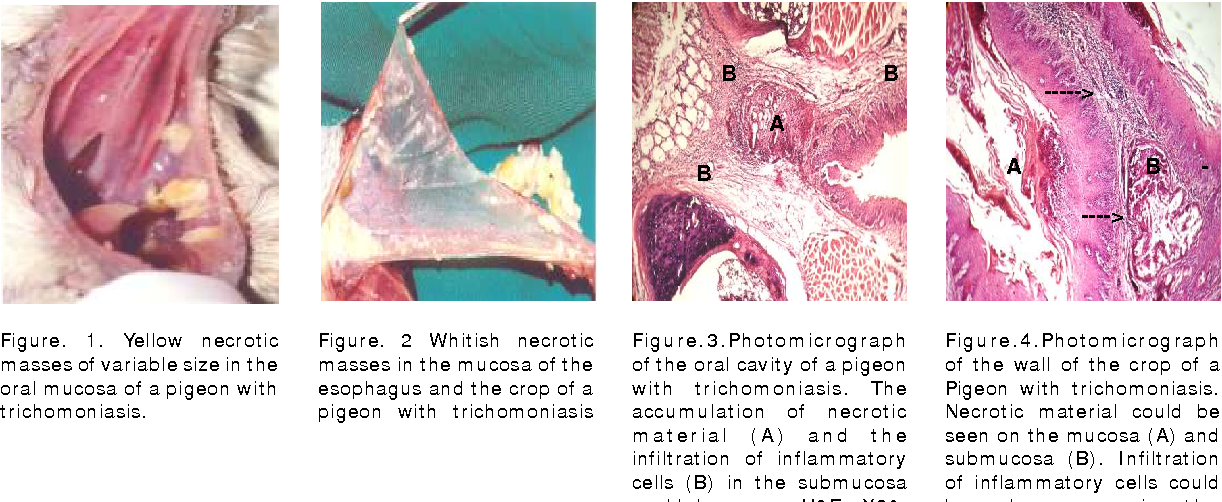Trichomoniasis in Budgies causes of death of many Budgies by wrong diagnoses by many owners and sometimes even vets. It is time to prevent and treat sick budgies with this parasite!
Also known as Frounce (in raptors) or Canker (in pigeons and budgies), Trichomoniasis is a bird infection that is caused by a motile protozoan parasite called Trichomonas gallinae. This parasite usually concentrates in the upper parts of a bird’s digestive and respiratory systems.
These parts include the pharynx, mouth, crop, and sinuses – the trachea, lungs, and liver are occasionally affected as well. While this disease mostly targets pigeons, budgies, and raptors, it can also infect falcons, chickens, doves, turkeys, quail, hawks, and canaries.
Trichomonas gallinae causes severe damage to the tissues of the birds’ mouth, throat, sometimes other internal organs… Trichomonas gallinae causes starvation or suffocation by blocking the passage of air and food of the bird.

How do budgies get Trichomoniasis?
Since the protozoa responsible for this disease can’t survive in the environment for long periods, it can’t be transmitted through air or aerosol. Instead, it is usually transmitted through direct contact. This is usually through:
Direct mouth to mouth contact between budgies
This commonly happens when a parent is feeding their young. And since subclinically infected adults can carry this parasite for long periods, they can infect their offspring again and again. Also, adult birds have bill-to-bill contact during courtship, making it easy for the protozoa to move from one bird to another.
Contaminated water, food, and bedding
When a bird infected with Trichomoniasis is eating or drinking water, it may be unable to effectively swallow due to oral lesions. This may lead to some grains or water falling back down to the ground, into the water source, or into the feeder. So when a budgie comes and consumes these fallaways, they can easily become infected with the disease.
Also, the droppings of infected birds are highly contagious, making the beddings of such birds a danger to healthy budgies. On the bright side though, at least budgies aren’t birds of prey. If they were, they could additionally get infected by eating other birds.

What are the symptoms of Trichomoniasis in budgies?
While some birds are subclinical carriers of Trichomoniasis and exhibit no symptoms, some do. Some of the symptoms of this disease include:
- Oral lesions
- Poor growth (in young birds)
- Green droppings/diarrhea
- Vomiting and/or regurgitation
- Weight loss and trouble eating- you may notice your bird reaching for the smallest seeds because they are less painful to swallow
- White plaques in the bird’s mouth
- Labored breathing
- Ruffled appearance
- Puffy neck
- Inability to close its mouth due to lesions
- Lack of balance and difficulty standing
- Depression and excessive salivation
- Listlessness
- Repeated swallowing movements
- Watery eyes
- Distended crop
- Odor
- Death due to starvation or suffocation

How is Trichomoniasis diagnosed?
If the vet suspects your budgie has Trichomoniasis, they will conduct a physical exam and take samples from the lesions or the white plaques in your bird’s mouth. Afterward, they will examine these samples under a microscope to identify the parasite.

How do you treat Trichomoniasis in budgies?
Once it has been established that your budgie has Trichomoniasis, your vet will prescribe antiprotozoal medication such as:
- Carnidazole (Spartrix) – this is usually administered in a single dose
- Metronidazole (Flagyl) – this can be applied orally for 2 to 10 days
- Ronidazole (Ronnivet-S.) – this will need to be added to your budgie’s water for 7 days (it has a wide safety margin)
- Other drugs like Dimetridazole, Copper Sulfate, Quaternary Ammonia, Amino Nitrothiazole, Emtryl, and Enheptin
It’s important to note that some of these drugs are still under review though – something you should discuss with your vet during prescription. While most birds usually recover from Trichomoniasis, those who are severely debilitated or resistant to nitroimidazole drugs may die.
To increase your budgie’s chances of survival, your vet may hospitalize them and place them under intensive care treatment to ensure they get the nutrients and fluids they need. Interestingly, mild infections of Trichomoniasis can result in immunity to other strains of Trichomonas gallinae.

How to control and prevent Trichomoniasis in budgies
To control and prevent Trichomoniasis in budgies, you should:
- Quarantine any new birds until they get checked for Trichomoniasis
- Give emancipated birds high-energy soft/liquid food supplements
- Place a heat source like a bulb in the room the birds stay in
- Give vomiting birds fluids subcutaneously or intravenously
- Treat birds with any infection immediately, even if they are carriers
- Clean and disinfect dishes, water bowls, and cages regularly using 10% bleach solution
- Keep adult birds away from their infected offspring. In fact, keep adult birds away from young birds entirely
- Keep susceptible birds from carriers or recovered birds
- Keep your pet budgie away from wild birds – they can be great sources of contamination

Can humans and other animals get Trichomonas gallinae from birds?
While Trichomonas gallinae is highly contagious among birds, it can’t be transmitted to other animals or humans.
Be attentive to your budgie
Ultimately, the best way to keep your budgie healthy is to be attentive to them and take them to the vet immediately if you notice something out of the ordinary. The sooner Trichomoniasis is diagnosed, the better the prognosis!
Recent Posts
Budgies are highly social animals that thrive on attention, interaction, and mental stimulation. While they may not "die" directly from boredom, chronic lack of stimulation can lead to serious health...
I'm excited to share that I've created a 2025 calendar for the Budgie Nation community, available for free download on the Alen AXP webpage! Feel Free to subscribe to Alen AxP, Already above 1M...



2 thoughts on “Trichomoniasis in Budgies, Trichomoniasis Treatment, and Symptoms”